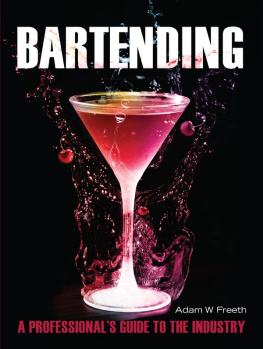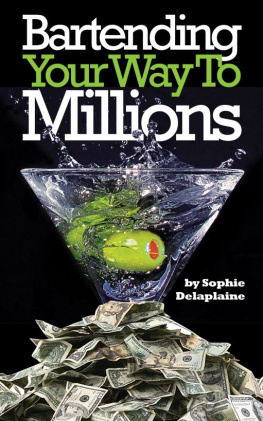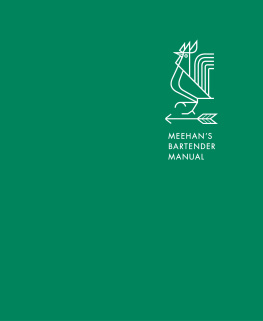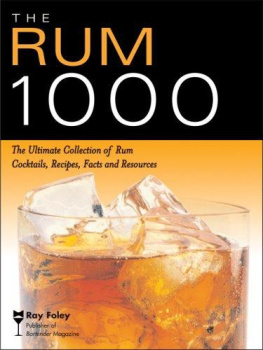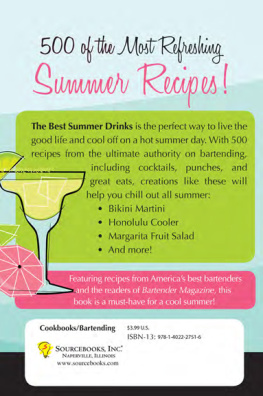Bartending Basics
A Complete Beginners Guide
by
Thomas Morrel
Copyright Notice
Copyright Pratzen Publishing 2011. All rights reserved. None of the materials in this publication may be used, reproduced or transmitted, in whole or in part, in any form or by any means, electronic or mechanical, including photocopying, recording or the use of any information storage and retrieval system, without permission in writing from the publisher.
ISBN 978-0-9796243-4-6
Trademark Disclaimer
Product names, logos, brands, URLs, web site links, and other trademarks featured or referred to within this publication or within any supplemental or related materials are the property of their respective trademark holders. These trademark holders are not affiliated with the author or publisher and the trademark holders do not sponsor or endorse our materials.
Copyright Acknowledgement
Photographs attributed to a third party are the property of such third party and are used here by permission. All such attributed photographs are subject to the copyright claims of each respective owner.
Legal Disclaimer
This publication provides information about the storage auction industry and includes references to certain legal and accounting principles. Although the author and the publisher believe that the included information is accurate and useful, nothing contained in this publication can be considered professional advice on any legal or accounting matter. You must consult a licensed attorney or accountant if you want professional advice that is appropriate to your particular situation.
What is the difference between God and a bartender?
Answer: God does not think he is a bartender.
Preface
I work in the hospitality industry and have since I was thirteen years old. It is what I do and it is what I know. Specifically, I work in restaurants. I have done everything there is to do in a restaurant. I have been a busboy, dishwasher, host, cook, waiter, manager and lastly a bartender. This last occupation is what this book is about. Far and away, this is my favorite activity in a restaurant. In the movie Cocktail, it is said that a bartender is the aristocrat of the working class. This is true. When you are behind the bar, you are in control of it all. Men accord you respect and the ladies look on with awe. It is a liberating and empowering experience that needs to be lived to be understood.
A bartending career can also offer you many advantages. First of all, there is the money. Bartenders make lots of money in tips and take cash home every night. Bartending also offers lots of flexibility. I worked as a bartender the entire time I was in college. I know plenty of bartenders who take care of their children during the day while their spouse is at work. At night, they work and their spouse cares for the children. Bartending is also the type of job you can go anywhere to do, any town in this country has a bar and needs someone to pour the drinks. I know bartenders that have lived on Caribbean islands and worked as bartenders on cruise ships as well. Your options are wide and many with a bartending career.
Many people have approached me during the years (some have even rudely called during a Saturday night rush to ask) how one becomes a bartender. They want to be back there. This book is the answer to all those questions and is about how I became a bartender. Inside I will tell you how you can do the same things I have done and go where I have gone.
When I originally started working as a server, I was exposed to a number of bartenders who had attended a bartending school. I did not attend one of these and pulled myself up on my own, learning as I went. A lot of these schools charge very high tuition and I thought that a self study book with a similar curriculum and tests would be appreciated by al those people out there who longed to do what I do.
This book is the product of that idea. You will find that the layout contained in these covers is that of a classroom. You will be presented with a body of text that discusses one aspect of being a successful bartender. You will need to read through this text and digest the information it contains. Along with facts, techniques and concepts, you will also find many anecdotal experiences from my career thrown in. These are used to further illustrate a point or philosophy that I have regarding a particular subject. At the end of each chapter may find a series of review questions, a quiz, or a homework assignment. I have found that these tools often help to reinforce what a person has just read and further plant the ideas contained in a chapter.
Now, the subtitle of this book is A Complete Beginners Guide. Pay attention to that for a second. Contained in this book are only the basic tools, techniques and concepts that are needed to become a bartender. Reading and studying this book does not guarantee any success in this career path. You will need to put forth a great deal of effort, patience, and hard work if you are to be successful. You need to have a good mindset and a friendly personality if you wish to rise to the top. You need to memorize your recipes and thoroughly understand the ideas presented here. However, with hard work and discipline, there is no reason that you cannot one day stand behind the bar and be an Aristocrat of the Working Class.
-Thomas Morrel
Chapter 1
Beer

When beer was discovered by humans is a fact that will probably never be known. We do know that beer was a staple food of the Ancient Mesopotamians and Egyptians and made up a large percentage of their diet. The point is that beer has been around for thousands of years and humans love it and beer consumption in the world continues to rise each year as countries like China (the worlds largest beer consumer) continue to develop a taste for the beverage.
Beer is one of the many things you will be pouring into glasses as a bartender so you will need to be familiar with it. It used to be the case that a bar would only carry several mass produced pilsner style beers. This has changed. American beer drinkers have developed many wide and varying tastes for different beer styles from across the globe. Exotic imported English brown ales share tapboards with German lagers, Irish stouts and Mexican or Chinese pilsners. I know bars that proudly offer over one hundred beers on draft alone with even more in the bottle.
Most of the readers of this book will be familiar with beer through having consumed it. However, you should know more than that as a bartender. You will need to understand the basic process of making beer. You will also need to know the difference between and be able to differentiate various beers. You need to know how to pour a beer for maximum enjoyment. You will need to know how to taste beer. Lastly, you need to be able to talk beer and communicate ideas such as flavors to your guests. We will discuss all of these ideas and techniques in this chapter of the book.
The Process Of Making Beer
Making beer is a fairly simple process that can take years to master. In a nutshell, you cook water, a type of grain (this is usually a malted barley and maybe wheat) and hops to make a sugary liquid call wort. This liquid is then placed in a vessel known as a fermenter where it is cooled and a small amount of bacteria called yeast is introduced to the mix and the batch is allowed sit.
Yeast is a remarkable type of bacteria that is extremely valuable to humans. This primitive single celled type of bacteria survives by eating sugar. The sugar undergoes a chemical process whereby the sugar molecule is converted to alcohol, carbon dioxide and energy for the yeast cell. This energy is by the yeast to reproduce and make other yeast cells to eat more sugar, make more alcohol, sugar and energy and to reproduce again. This process is repeated millions and millions of times in a fermenter until all of the sugar has been eaten. Yeast is actually responsible for every type of alcoholic beverage and naturally occurs on many types of fruits.




